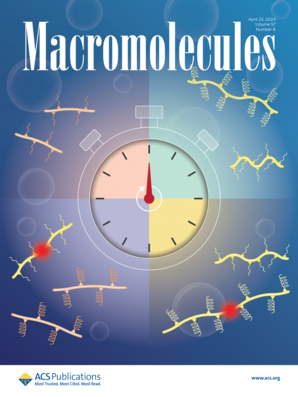Elastin-Based Janus Hydrogel Tape with Adhesive, Stretchable, and Conductive Properties for Soft Bioelectronic Applications
IF 5.1
1区 化学
Q1 POLYMER SCIENCE
引用次数: 0
Abstract
Achieving robust adhesion and optimal conductivity simultaneously is highly important and challenging for soft bioelectronics. Although numerous adhesive hydrogels have been investigated, they are designed for double-sided adhesion and lack optimal sensing performance. Therefore, we developed a two-step casting strategy to fabricate Janus hydrogel tape (J-Tape) for soft bioelectronics. The J-Tape was composed of an adhesive poly(acrylic acid)-N-hydroxysuccinimide/elastin-methacrylate (PAAc-NHS/ElaMA) bottom layer and a nonadhesive poly(acrylic acid)/gelatin-methacrylate (PAAc/GelMA) top layer and exhibited multiple functions, such as sufficient bioadhesion, high stretchability, optimal sensitivity, and good biocompatibility. Benefiting from the NHS ester group, the bottom layer can rapidly and robustly adhere to biological tissues. In addition, the top layer was supplemented with PEDOT:PSS (poly(3,4-ethylenedioxythiophene):poly(styrenesulfonate)) to enhance its conductive performance. The application of this J-Tape for tissue adhesion and wound sealing in vitro was successfully demonstrated. When exploited as a strain sensor to monitor diverse physiological signals, the hydrogel showed excellent sensitivity and reliability. Furthermore, J-Tape was integrated with a machine learning algorithm and developed into a wireless wearable electronic sensing system that can recognize diverse gestures with up to 98.87% accuracy. Overall, this work may provide new insights for the design and fabrication of functional bioelectronics.

基于弹性蛋白的Janus水凝胶带,具有粘合剂,可拉伸性和导电性能,用于软生物电子应用
同时实现强大的附着力和最佳的导电性对软生物电子学来说是非常重要和具有挑战性的。虽然已经研究了许多胶粘剂水凝胶,但它们都是为双面粘连而设计的,缺乏最佳的传感性能。因此,我们开发了一种两步铸造策略来制造用于软生物电子学的Janus水凝胶带(J-Tape)。J-Tape由粘接型聚丙烯酸- n-羟基丁二酰亚胺/甲基丙烯酸弹性酯(PAAc- nhs /ElaMA)底层和非粘接型聚丙烯酸/甲基丙烯酸明胶(PAAc/GelMA)表层组成,具有良好的生物粘附性、高拉伸性、最佳灵敏度和良好的生物相容性等多种功能。受益于NHS酯基,底层可以快速而牢固地粘附在生物组织上。此外,在顶层添加PEDOT:PSS(聚(3,4-乙烯二氧噻吩):聚(苯乙烯磺酸盐))以增强其导电性能。成功地证明了J-Tape在体外组织粘连和伤口密封中的应用。作为应变传感器监测各种生理信号时,水凝胶表现出优异的灵敏度和可靠性。此外,J-Tape集成了机器学习算法,并开发成一种无线可穿戴电子传感系统,可以识别各种手势,准确率高达98.87%。总的来说,这项工作可能为功能性生物电子学的设计和制造提供新的见解。
本文章由计算机程序翻译,如有差异,请以英文原文为准。
求助全文
约1分钟内获得全文
求助全文
来源期刊

Macromolecules
工程技术-高分子科学
CiteScore
9.30
自引率
16.40%
发文量
942
审稿时长
2 months
期刊介绍:
Macromolecules publishes original, fundamental, and impactful research on all aspects of polymer science. Topics of interest include synthesis (e.g., controlled polymerizations, polymerization catalysis, post polymerization modification, new monomer structures and polymer architectures, and polymerization mechanisms/kinetics analysis); phase behavior, thermodynamics, dynamic, and ordering/disordering phenomena (e.g., self-assembly, gelation, crystallization, solution/melt/solid-state characteristics); structure and properties (e.g., mechanical and rheological properties, surface/interfacial characteristics, electronic and transport properties); new state of the art characterization (e.g., spectroscopy, scattering, microscopy, rheology), simulation (e.g., Monte Carlo, molecular dynamics, multi-scale/coarse-grained modeling), and theoretical methods. Renewable/sustainable polymers, polymer networks, responsive polymers, electro-, magneto- and opto-active macromolecules, inorganic polymers, charge-transporting polymers (ion-containing, semiconducting, and conducting), nanostructured polymers, and polymer composites are also of interest. Typical papers published in Macromolecules showcase important and innovative concepts, experimental methods/observations, and theoretical/computational approaches that demonstrate a fundamental advance in the understanding of polymers.
 求助内容:
求助内容: 应助结果提醒方式:
应助结果提醒方式:


